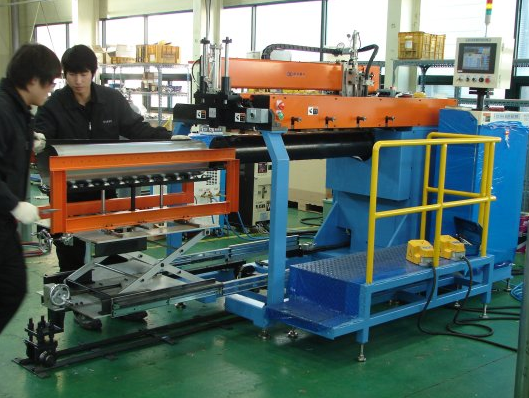|
ROBOT VALLEY Co., Ltd. (www.robotvalley.kr) was established as a part of the Gyeongnam Robot Valley Project in 2000 and has since then been leaders in the field by providing cutting-edge intelligent robot technology for manufacturing in Gyeongnam Province.
The company is made up of robot engineers who have more than 25 years of experience in robotics and automation systems. Based on their reserve of technology and experience amassed over many years, their mission is to develop cutting edge intelligent robots for manufacturing and to supply optimal robot systems according to their customers’ specifications.
ROBOT VALLEY Co., Ltd. has a hand in everything from the design, manufacturing, installation and test runs of automation systems, bead inspection devices, sheet metal welding equipment, and lens transfer robots.
The company’s solutions in the field of robot automation systems include the handling robot, welding robot, paint robot, and waterjet / assembly / inspection systems.
| |
 |
|
| ▲Handling Robotic System |
Equipped with an end-effector (e.g. gripper), the Handling Robotic System transports the object. Handling robotic systems can reduce direct labor costs and be used for tasks that are dangerous, and require simple repetitive movements or hard physical labor. In addition, the use of robots for handling sensitive materials can minimize the occurrence of damage. The handling robot system can be interfaced with conveyers, automatic conveying equipment, monorails, automatic containers, and other transport equipment.
| |
 |
|
| ▲Welding robots |
In the field of welding robots, the goal is for the robots to produce superior quality welding work; this is done through a high-performing skilled welder producing an ideal example of welding and “interpreting” the results for the robot. However, because in welding work the accuracy and position of the welding material is always varied, the work often depends on the experience of the welder; hence, the final product relies less on the robot’s operating skills and more on awareness of and adjustment for factors such as welding equipment performance, weld bead shape, and identifying the conditions that cause defects. Robot welding systems include Spot Welding System, CO2 Welding System, MIG / MAG Welding System, TIG Welding System, and Plasma Welding System.
In the Spray Painting Robotic System, the most commonly used painting methods are Air Spray Painting, Airless Spray Painting, Electrostatic Painting and Electrostatic Powder Painting. The robotic system is able to imitate the work of skilled painters to continuously and stably produce high quality painting. Conveyor, Trolley, Shuttle, Swing Twister can be applied to the production line methods.
The quality of the Water-Jet Cutting Robotic System is so high that it does not require a finishing step for the cut section; it is also able to cut a wide range of materials usually with just one cutting action. No flame or heat is generated while the material is being cut. The waterjet cutting robot system provided by ROBOT VALLEY combines Flow's waterjet technology with ROBOT VALLEY’s accumulated robot technology to meet the diverse needs of customers.
For humans, the process of “Deburring” creates undesirable working conditions such as noise, vibration and dust generation. However, deburring requires sophisticated human movement, which can only be replaced by industrial vertical six-axis articulated robots. ROBOT VALLEY assumes responsibility for the design, manufacture, tests, and training of the deburring system – all on site, based on the customer’s needs.
The Assembly Robotic System’s precision and speed allows assembly work such as transferring, attaching, and finishing of parts to be completed quickly and easily.
The Inspection Robotic System is able to quickly detect defects in the assembled product itself or in the marks and labels with its machine recognition system. The company is able to deliver inspection systems whose in-house-created machine vision system can be interfaced with the robot and peripheral equipment, according to the customer’s needs.
| |
 |
|
| ▲Lens transfer Robot |
In addition to these robot automation systems, the company has also developed products such as the non-contact laser weld bead inspection instrument B-one; an aspherical lens Loading/Unloading automated lens transfer Robot, and a thin plate plasma welding device. In 2008, B-one, Korea’s first weld bead measuring machine, received the NEP (New Excellent Product) certification. The lens transfer robot supplies the raw materials for the lens and performs the preparatory work for molding (washing and transferring of the multi head and the raw material before molding). After molding, this comprehensive work robot discharges the lens after molding from the multihead, which is itself discharged from the molding chamber.
| |
 |
|
| ▲Thin plate plasma welding device |
ROBOT VALLEY is one of only a handful of robot companies in Korea who can design and manufacture robots with strict tests adhering to the ISO9283 standard. They have developed various industrial robot systems such as welding, forging, machine handling, painting robots, and deburring systems with the use of a robot simulator. With their applications in the industrial field, they have already begun implementing a smart factory.
More than 10% of its sales have been invested in technology development, and they have honed their technical skills through their various government-funded projects. They possess dozens of systems including system control device design and production, robot system engineering, factory automation systems, semiconductor equipment development and production equipment.
|
